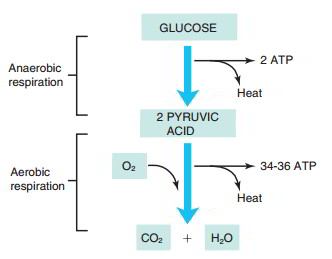Cells need a consistent supply of energy to power the chain reaction of life. This energy is straight provided by ATP molecules Due to the fact that cells have a minimal supply, ATP molecules should continuously be produced by cellular respiration in order to sustain life.
Cellular respiration is the process that breaks down nutrients in the cells to release energy kept in their chemical bonds and transfers a few of this energy into the high-energy phosphate bonds of ATP. About 40% of the energy in a nutrient molecule is “recorded” in this method; the rest is lost as heat Glucose, a carbohydrate molecule, is the main nutrient utilised in cellular respiration; nevertheless, the building systems of proteins and lipids are likewise utilised.
The real process of cellular respiration of glucose is complex, however, might be simplified as the formula listed below. Keep in mind that the breakdown of glucose (C6 H12O6) needs oxygen (O2) and yields co2 (CO2) and water (WATER). The energy released is utilised to form ATP from ADP and Pi (phosphate group). A few of the energy is released as heat.
Cellular respiration includes 2 consecutive processes: anaerobic respiration and aerobic respiration Each chemical process includes numerous actions, with each action needing an unique enzyme. Anaerobic respiration does not need oxygen takes place in 2 significant actions. Anaerobic respiration takes place in the cytosol, does not need oxygen, and yields a net of 2 ATP. Aerobic respiration takes place in mitochondria, needs oxygen, and yields a net of 34–36ATP. About 40% of the energy in the chemical bonds of glucose is recorded to form ATP molecules.
It breaks down a six-carbon glucose molecule into 2 three-carbon pyruvic acid molecules to yield a net of 2 ATPmolecules The low level of ATP production by anaerobic respiration is inadequate to keep an individual alive. An individual denied of oxygen or of the capability to utilise oxygen in cellular respiration (as in cyanide poisoning) rapidly passes away since anaerobic respiration does not offer adequate ATP to sustain life.
Aerobic respiration, the 2nd part of cellular respiration, (1) needs oxygen, (2) takes place just within mitochondria, and (3) is vital for human life. Aerobic respiration releases the energy in the high-energy electrons produced by anaerobic respiration, breaks down the 2 pyruvic acid molecules produced by anaerobic respiration into co2 and water, and yields a net of 34–36ATPmolecules Hence, the respiration of a molecule of glucose yields a net overall of 36–38ATP.


 (59 votes, average: 4.47 out of 5)
(59 votes, average: 4.47 out of 5)